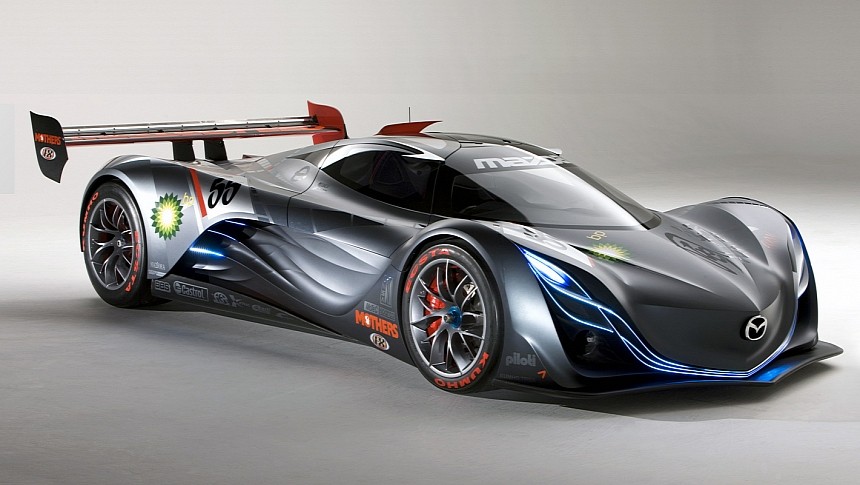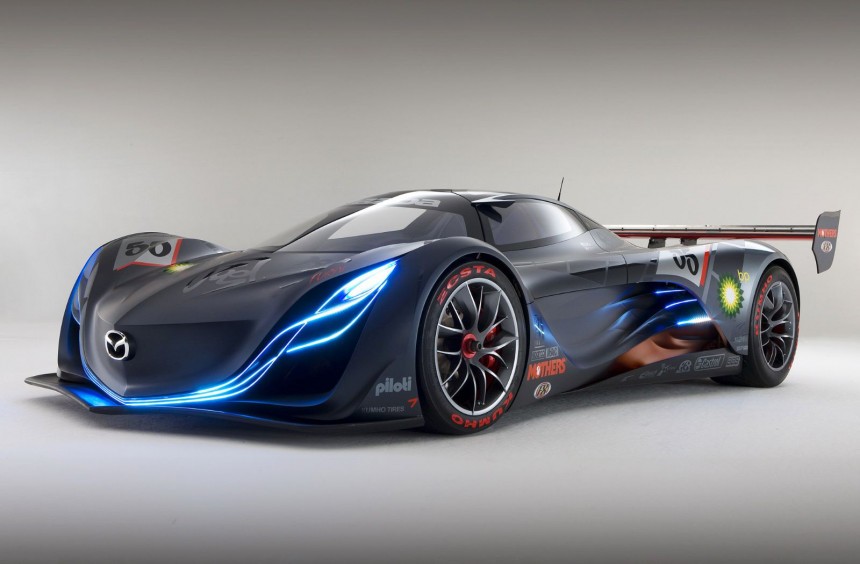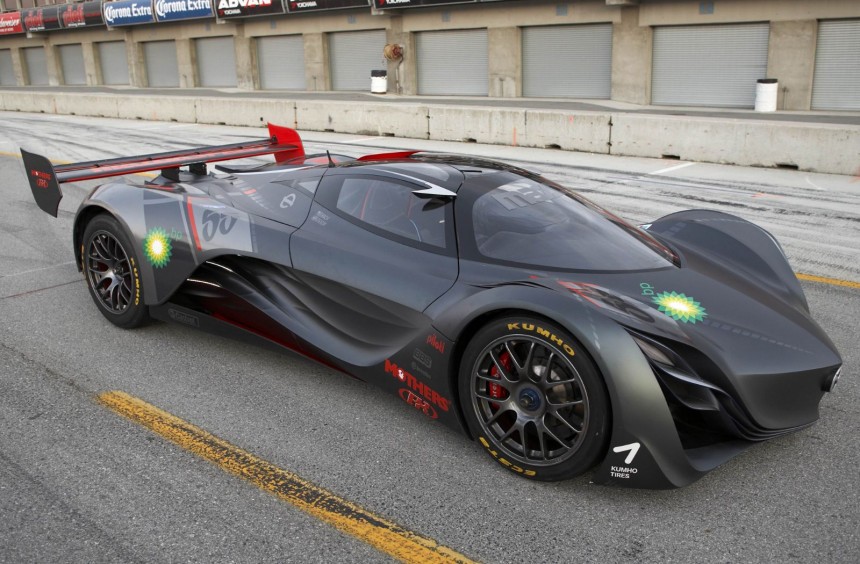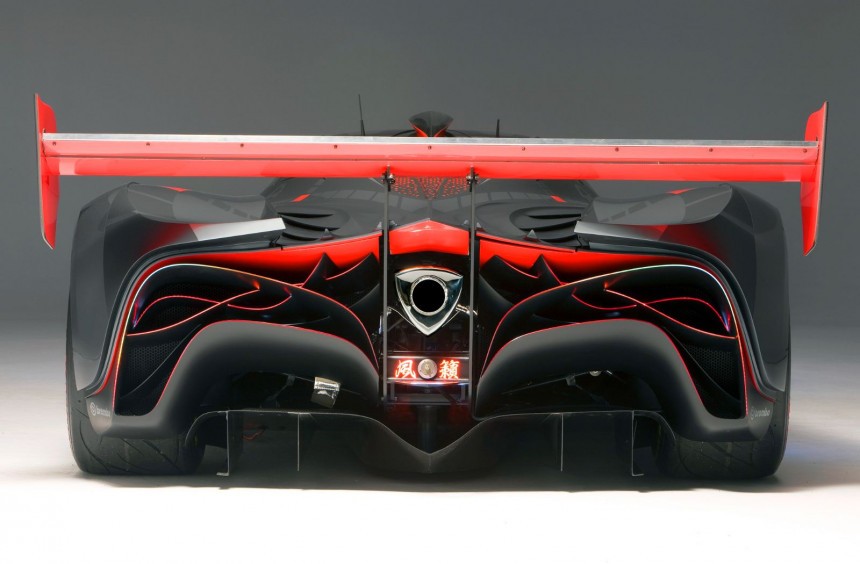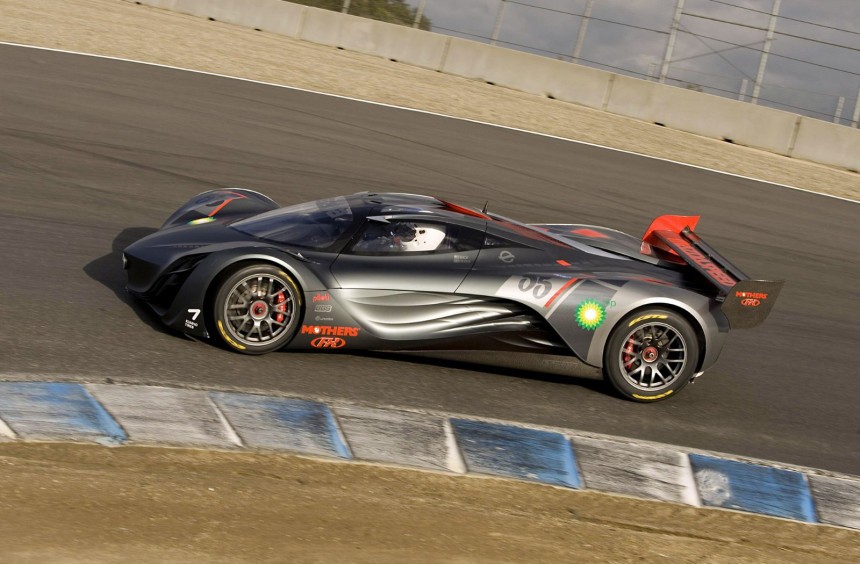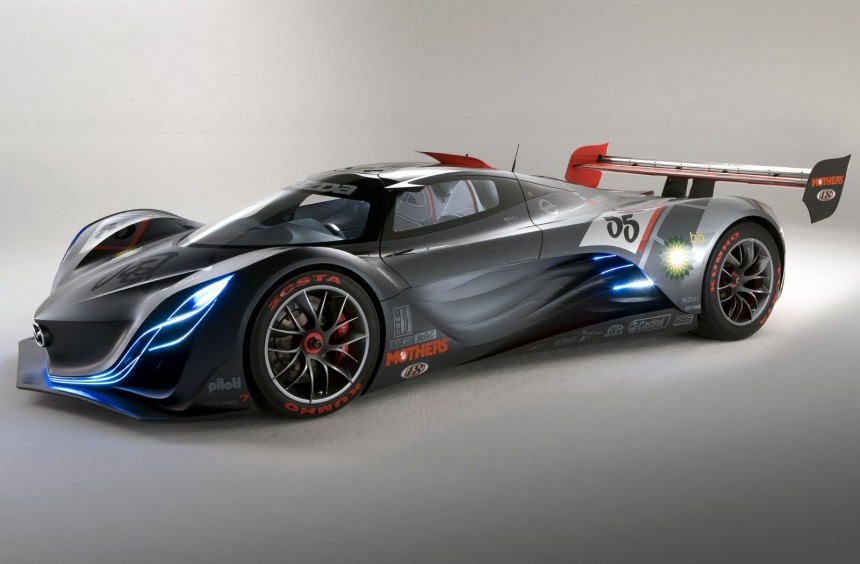With a beautifully sculptured body and a potent three-rotor engine, the Furai seemed destined to succeed the LeMans-winning 787B on the track, but an unfortunate incident sealed its faith just a few months after its official debut.
With a few exceptions, like the FD RX-7, Mazda's production models of the 1990s were by no means design icons.
Aiming to improve the looks of its vehicles, the Japanese carmaker hired famed stylists Franz von Holzhausen and Laurens van den Acker during the second part of the 2000s.
With the two new hires heading the company's revamped styling department, Mazda debuted a new design language called Nagare ("flow" in Japanese) that would eventually shape its production models.
But, before those models were launched, the manufacturer introduced a series of futuristic concepts designed around the new Nagare philosophy.
The series started with a 2006 concept named after the design language. Then, in 2007, it continued with the Ryuga and Hakaze.
Finally, at the 2008 North American International Auto Show in Detroit, Mazda unveiled the last and arguably most beautiful Nagare concept.
Dubbed Furai, the concept was designed by Mazda's styling department in collaboration with American spacecraft engineering firm Swift Engineering.
Its breathtaking body featured Nagare cues combined with shapes conceived to make it as aerodynamically efficient as possible.
Unlike the previous Nagare show cars, the Furai was a fully functional race car built around the Courage C65 LMP2 chassis used by Mazda in the American Le Mans Series during the 2006 and 2007 seasons.
Fabricated from a mix of aluminum alloy and carbon fiber, the monocoque at the heart of the Furai featured an independent suspension system with double wishbones, pushrods, and horizontally mounted dynamic shock absorbers.
But, while it was built around a tried-and-true motorsport chassis, the concept's body was sculptured to bridge the gap between a road-legal supercar and a LeMans prototype.
Therefore, the Furai looked more like a road car than a closed-cockpit endurance racing machine, which made the potential development of a street-legal version plausible.
However, this was a thoroughbred race car, so the interior was designed accordingly.
Stylists focused on weight-saving and ergonomics, so the cockpit featured two slim carbon-fiber bucket seats with harnesses and a motorsport steering wheel designed for this car by Sparco.
Honoring the legendary 787B that helped Mazda win the prestigious 24 Hours of Le Mans endurance race in 1991, the Furai also featured a mid-mounted rotary engine.
But, unlike the 787's fire-spitting R26B four-rotor engine, the concept's unit only featured three rotors.
Displacing 2.0 liters, the R20B Renesis was developed by renowned rotary tuners Racing Beat, who based their design on the Eunos Cosmo's 20B-REW - the only three-rotor ever fitted into a production car.
Naturally aspirated and linked to an X-trac six-speed sequential gearbox, the race engine was tuned to run on pure ethanol (E100) biofuel developed by BP.
According to Mazda, the engine could develop 450 hp, which wasn't a mind-blowing figure, but since the whole car weighed just 1,488 pounds (675 kg), it was more than enough to help it hit 60 mph from a standstill in 3.2 seconds.
Apart from the unique engine, Racing Beat also built a custom rotary-shaped muffler for the car, one of its most awesome visual features.
Sitting on BBS center-lock wheels wrapped with slicks specifically developed for the project by Khumo, the Furai hit the track soon after it was unveiled.
It was tested extensively on various tracks, including Laguna Seca and Buttonwillow.
Thanks to its futuristic, yer aerodynamic body bolstered with a front splitter, a prominent rear spoiler, and a diffuser, the concept produced massive amounts of downforce. Despite that, it maintained a low drag coefficient, which made it surprisingly fast through tight corners.
According to a Top Gear magazine interview with head designer Laurens van den Acker, Mazda considered adapting the concept for official endurance racing, presumably eyeing an entry to the 24 Hours of Le Mans as an experimental entry.
Moreover, the designer hoped a road-legal version would make it into production.
Unfortunately, the Furai project never made it past the testing stages.
In August 2008, the beautiful concept was flown to England, where it was scheduled to perform additional tests and take part in a photo session organized by Top Gear at the former Royal Air Force Bentwaters airfield.
With experienced British race driver Mark Ticehurst behind the wheel, the Furai's three-rotor suddenly caught fire. Ticehurst managed to get out in time, but the car continued to burn.
Since the incident occurred on an isolated part of the makeshift track, firefighters didn't arrive in time to save the concept, which was essentially burnt to a crisp.
Mazda kept the incident under wraps as it conducted a thorough investigation. The company finally allowed Top Gear to write a story about the race car's unfortunate demise in 2013, but it never released details about the cause to the public.
While I am no expert, it's safe to assume that the engine's novel fuel system and the high flammability of the fuel itself were at the heart of the incident.
But cause aside, the Furai was one of Mazda's most stunning concept cars, and, unfortunately, it never got a chance to showcase its potential in an official race.
If you want to see the breathtaking race car in action on the track, we recommend watching the YouTube video below by Tim Brown.
Aiming to improve the looks of its vehicles, the Japanese carmaker hired famed stylists Franz von Holzhausen and Laurens van den Acker during the second part of the 2000s.
With the two new hires heading the company's revamped styling department, Mazda debuted a new design language called Nagare ("flow" in Japanese) that would eventually shape its production models.
But, before those models were launched, the manufacturer introduced a series of futuristic concepts designed around the new Nagare philosophy.
The last and arguably most beautiful Nagare concept
Finally, at the 2008 North American International Auto Show in Detroit, Mazda unveiled the last and arguably most beautiful Nagare concept.
Dubbed Furai, the concept was designed by Mazda's styling department in collaboration with American spacecraft engineering firm Swift Engineering.
Its breathtaking body featured Nagare cues combined with shapes conceived to make it as aerodynamically efficient as possible.
A thoroughbred race car
Fabricated from a mix of aluminum alloy and carbon fiber, the monocoque at the heart of the Furai featured an independent suspension system with double wishbones, pushrods, and horizontally mounted dynamic shock absorbers.
But, while it was built around a tried-and-true motorsport chassis, the concept's body was sculptured to bridge the gap between a road-legal supercar and a LeMans prototype.
Therefore, the Furai looked more like a road car than a closed-cockpit endurance racing machine, which made the potential development of a street-legal version plausible.
However, this was a thoroughbred race car, so the interior was designed accordingly.
Stylists focused on weight-saving and ergonomics, so the cockpit featured two slim carbon-fiber bucket seats with harnesses and a motorsport steering wheel designed for this car by Sparco.
Powered by a custom three-rotor engine
But, unlike the 787's fire-spitting R26B four-rotor engine, the concept's unit only featured three rotors.
Displacing 2.0 liters, the R20B Renesis was developed by renowned rotary tuners Racing Beat, who based their design on the Eunos Cosmo's 20B-REW - the only three-rotor ever fitted into a production car.
Naturally aspirated and linked to an X-trac six-speed sequential gearbox, the race engine was tuned to run on pure ethanol (E100) biofuel developed by BP.
According to Mazda, the engine could develop 450 hp, which wasn't a mind-blowing figure, but since the whole car weighed just 1,488 pounds (675 kg), it was more than enough to help it hit 60 mph from a standstill in 3.2 seconds.
Apart from the unique engine, Racing Beat also built a custom rotary-shaped muffler for the car, one of its most awesome visual features.
Extensively tested on the track
It was tested extensively on various tracks, including Laguna Seca and Buttonwillow.
Thanks to its futuristic, yer aerodynamic body bolstered with a front splitter, a prominent rear spoiler, and a diffuser, the concept produced massive amounts of downforce. Despite that, it maintained a low drag coefficient, which made it surprisingly fast through tight corners.
According to a Top Gear magazine interview with head designer Laurens van den Acker, Mazda considered adapting the concept for official endurance racing, presumably eyeing an entry to the 24 Hours of Le Mans as an experimental entry.
Moreover, the designer hoped a road-legal version would make it into production.
A hot concept that burnt to a crisp
In August 2008, the beautiful concept was flown to England, where it was scheduled to perform additional tests and take part in a photo session organized by Top Gear at the former Royal Air Force Bentwaters airfield.
With experienced British race driver Mark Ticehurst behind the wheel, the Furai's three-rotor suddenly caught fire. Ticehurst managed to get out in time, but the car continued to burn.
Since the incident occurred on an isolated part of the makeshift track, firefighters didn't arrive in time to save the concept, which was essentially burnt to a crisp.
Mazda kept the incident under wraps as it conducted a thorough investigation. The company finally allowed Top Gear to write a story about the race car's unfortunate demise in 2013, but it never released details about the cause to the public.
While I am no expert, it's safe to assume that the engine's novel fuel system and the high flammability of the fuel itself were at the heart of the incident.
But cause aside, the Furai was one of Mazda's most stunning concept cars, and, unfortunately, it never got a chance to showcase its potential in an official race.
If you want to see the breathtaking race car in action on the track, we recommend watching the YouTube video below by Tim Brown.
